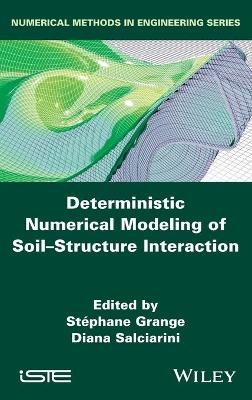
Deterministic Numerical Modeling of Soil Structure Interaction
ISTE Ltd and John Wiley & Sons Inc (Verlag)
978-1-78630-798-9 (ISBN)
Furthermore, this book provides insight on the DEM, adapted for interaction laws at the grain level. Within a classical finite element framework, the concept of macro-element is introduced, which generalizes constitutive laws of SSI and is particularly straightforward in dynamic situations. Finally, this book presents the SSI, in the case of a group of structures, such as buildings in a town, using the notion of metamaterials and a geophysics approach.
Stephane Grange is a Professor at the INSA in Lyon, France, and Director of the GEOMAS Civil Engineering Laboratory. His research focuses on the dynamic behavior of structures in interaction with their environment. Diana Salciarini is Associate Professor at the University of Perugia, Italy. Her research topics include: the analysis of soil-structure interaction phenomena under dynamic loading conditions, and coupled problems in geo-structure behavior under thermal cycles.
Introduction ix
Chapter 1. Hydro-mechanically Coupled Interface Finite Element for the Modeling of Soil–Structure Interactions: Application to Offshore Constructions 1
Benjamin CERFONTAINE and Robert CHARLIER
1.1. Introduction 2
1.1.1. The finite element method (FEM) 2
1.1.2. Review of existing contact formulations 3
1.1.3. Objectives 7
1.2. Governing equations of the interface problem 7
1.2.1 .Mechanical problem 8
1.2.2. Flow problem 12
1.2.3. Couplings between mechanical and flow problems 15
1.3. Numerical formulation of the element 16
1.3.1. Space and fluid pressure discretization 16
1.3.2. Mechanical problem 17
1.3.3. Flow problem 19
1.3.4. Time discretization 19
1.3.5. Stiffness matrix 20
1.4. Application 20
1.4.1. Suction caissons 20
1.4.2. Problem description 22
1.4.3. Tension loading 26
1.4.4. Lateral loading 37
1.5. Conclusion and perspectives 47
1.5.1. Conclusion 47
1.5.2. Perspectives 48
1.6. References 49
Chapter 2. DEM Approach for the Modeling of Geotechnical Structures in Interaction with Reinforcements 55
Pascal VILLARD
2.1. Introduction 55
2.2. Discrete modeling 56
2.2.1. General concepts of the discrete modeling approach 56
2.2.2. Specific interaction between discrete particles and reinforcement elements 59
2.2.3. Numerical strategy for geotechnical structure modelling using DEM 61
2.3. Application of the DEM to geotechnical structures in interaction with rigid piles 61
2.3.1. Load transfer mechanisms within granular embankments over a network of piles 64
2.3.2. Load transfer mechanisms within granular embankments over a network of piles under cyclic loadings 71
2.4. Application of the DEM to geotechnical structures in interaction with flexible and deformable reinforcement – comparison with experiment results 76
2.4.1. Numerical and experimental behavior of geosynthetic tubes filled with granular material 78
2.4.2. Numerical and experimental behavior of granular embankments reinforced with geosynthetic in areas prone to subsidence 87
2.5. Conclusion 96
2.6. References 96
Chapter 3. SSI Analysis in Geotechnical Engineering Problems Using a Finite Difference Method 101
Daniel DIAS and Orianne JENCK
3.1. Introduction 101
3.2. The finite difference method using an explicit scheme 102
3.3. Application of the finite difference method to soil–structure interaction problems 104
3.3.1. Structural elements 105
3.3.2. Interfaces 107
3.3.3. Constitutive models for soil 108
3.3.4. Dimension of the problem 111
3.3.5. Monotonic, quasi-static cyclic and dynamic loadings 112
3.4. Some application examples in the geotechnical engineering field 112
3.4.1. Reinforced retaining walls 112
3.4.2. Tunneling 115
3.4.3. Soft soil improvement using vertical rigid piles 121
3.5. Conclusion 138
3.6. References 139
Chapter 4. Macroelements for Soil–Structure Interaction 143
Diana SALCIARINI, Stéphane GRANGE, Claudio TAMAGNINI and Panagiotis KOTRONIS
4.1. Introduction 143
4.2. The concept of generalized forces: Eurocode 8 recommendations 145
4.3. Macroelements for shallow foundations 148
4.3.1. Generalities 148
4.3.2. Macroelements formulated in the framework of hardening elastoplasticity 150
4.3.3. Macroelements formulated in the framework of hypoplasticity 151
4.4. The considered macroelements 154
4.4.1. The elastoplastic macroelement 154
4.4.2. The hypoplastic macroelement 156
4.5. Case study: seismic response of a reinforced concrete viaduct 160
4.5.1. Features of the viaduct 160
4.5.2. The finite element model of the viaduct and its foundations 161
4.5.3. Seismic input 163
4.6. Calibration of the macroelements 164
4.7. Results of the numerical simulations 167
4.7.1. Forces and displacements in the structural elements 167
4.7.2. Displacements of the abutment and the foundations 170
4.8. Concluding remarks 172
4.9. References 175
Chapter 5. Urban Seismology: Experimental Approach to Soil–Structure Interaction Towards the Concept of Meta-city 181
Philippe GUÉGUEN, Philippe ROUX and Andrea COLOMBI
5.1. Introduction 181
5.1.1. Observation of soil–structure interaction under weak and strong seismic loading 183
5.1.2. Contamination of urban seismic motion by the vibration of buildings 196
5.1.3. Conclusion 202
5.2. References 203
List of Authors 211
Index 213
| Erscheinungsdatum | 25.01.2022 |
|---|---|
| Verlagsort | London |
| Sprache | englisch |
| Maße | 10 x 10 mm |
| Gewicht | 454 g |
| Themenwelt | Technik ► Bauwesen |
| ISBN-10 | 1-78630-798-7 / 1786307987 |
| ISBN-13 | 978-1-78630-798-9 / 9781786307989 |
| Zustand | Neuware |
| Haben Sie eine Frage zum Produkt? |
aus dem Bereich


